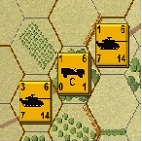rico21
Posts: 2990
Joined: 3/11/2016
Status: offline

|
Verdun
21 February - 18 December 1916
German side preparation:
In the middle of the war, at the beginning of 1916, the German general Falkenhayn decided to post troops near Verdun. For
a few kilometers, on February 21, 1916, he decided to explode everything: 2 million shells were sent within two days.
While the Germans launch several attacks in front, they are facing French soldiers, certainly less numerous, but able to
resist the opposing confrontations. However, they are nearly 5 km ahead. The same distance separates them from the town
of Verdun.
Riposte on the French side:
General Philippe Pétain was then responsible for managing French troops. He decided to bring the infantry from all over
France. The troops will be relayed in order to keep Platform to defend their bases. To do this, he has enlarged the
departmental road which goes as far as Verdun, it is called the Sacred Way. A truck arrives every 15 seconds at the front
and 90,000 men arrive there every week.
An endless battle:
Until July 1916, the Germans advanced. They attack both Douaumont and Fort de Vaux. A few kilometers ahead of them is
Verdun, they even see the coils of the cathedral. Before that, we must take the fort of Souville. After bombing for
several days this fort, well defended by the French, they tried to seize it. About fifty Germans manage to reach the top
but become prisoners. The failure of the capture of Fort Souville marked the end of the German advance at Verdun.
On the French side, thanks to the Sacred Way, there are 150,000 men and 500,000 soldiers. On their side, the British
attacked the Germans in Somme (Battle of the Somme) and the Russians attacked them in present-day Poland. The German
general Falkenhayn decides to position some troops in these two places, which then weakens the German infantry in Verdun.
At the end of October, the French resumed Douaumont, which they had lost a few months earlier. At the beginning of
November, it is the fort of Vaux that is in turn. In mid-December, the French and Germans occupied the same positions as
at the beginning of the battle.
Review of the Battle of Verdun:
It is a war of position: the Germans have very little progress (5 kilometers in 10 months), while it is one of the most
deadly battles of the First World War: there were 700 000 victims, then That the gain of territory for the Germans is
zero.
French losses: 378,000 victims including 62,000 killed, more than 101,000 missing and 215,000 injured.
German losses: 333,000 victims of which 143,000 killed and missing and 190,000 injured.
The symbol of Verdun:
The resistance of the French fighters to Verdun is related throughout the world. The small Meuse town acquires a
worldwide reputation. This defensive victory is regarded by the combatants as the victory of the whole French army, of
which the greater part of the contingent participated in the fighting. Of the 95 divisions of the French army, 70
participated. "Verdun, I was there! "Assert, with a mixture of pride and retrospective horror, the poilus who have come
back. For the whole nation, Verdun became the symbol of courage and self-denial.
They fought in Verdun:
A number of famous actors of the Second World War served in Verdun, and German testimonies and accounts of the Second
World War on the Eastern Front frequently refer to the memories and experience of the campaign. Verdun.
As early as 1942, some German officers noted that the Red Army was capable of gathering concentrations of artillery "as
has been seen since the battle of Douaumont". Future Blitzkrieg experts, Heinz Guderian and von Manstein both served in
Verdun, the first on the staff of the 5th Army, where he was an assistant intelligence officer, the second in the army,
The general staff of von Gallwitz.
Twenty-two years before heading the 6th German Army in Stalingrad, this Verdun of the Volga, Friedrich Paulus lived the
real battle, in 1916 he was Oberleutnant in the 2nd regiment of Prussian hunters, and he participated in the Battle of
Fleury in the month of June. Governor of Paris in 1942, General Carl-Heinrich von Stülpnagel commanded a battalion at
Verdun. A member of the conspiracy that tried to kill Hitler in July 1944, he attempted to commit suicide near the
Death-Man, but only succeeded in getting rid of himself. He was hanged a few weeks later.
One of Hitler's best generals, General Hans von Kluge, who commanded Army Group B, and also participated in the plot, had
been an artilleryman at Verdun in 1917. He was dismissed on the Normandy front, Was summoned to Berlin. In anticipation
of an arrest, he committed suicide on the way, shortly before Verdun, between Clermont-en-Argonne and Dombasle-en-Argonne.
Hitler's Chief of Staff Generaloberst Wilhelm Keitel served on the staff of the 10th reserve corps on the right bank of
the Meuse during the summer of 1916. Among the other German participants In the battle, the head of the SA, Ernst Röhm,
and his deputy, Rudolf Hess.
On the French side, besides Marshal Petain himself, the names of the French veterans, that of his future protégé, then
adversary, Charles de Gaulle. On March 2, 1916, the 33rd regiment of infantry where he served was attacked and decimated,
wiped out by the enemy while defending the village of Douaumont, near Verdun. His company is wounded in this fight and
the survivors are surrounded. De Gaulle was forced by force to jump into a shell-hole to protect himself, but Germans
followed him and wounded him with a bayonet stroke on the left thigh. Captured by the German troops, he was cared for
and interned. This disappearance at the front is worthy of being quoted to the order of the army.
In 1966, the year of the fiftieth anniversary of the battle, he was to declare: "The glory which Marshal Petain had
acquired at Verdun can not be disputed or ignored by his country."
German : --> [- : French
Scenario Length: 6 Game Turns - LOS (6Hexes)
Victory objective: The side with the required Victory Points is the winner. Both sides gets VPs for owning VP Objectives.
Scenario designer: Memoir44'Men [ Verdun ]
 Attachment (1) Attachment (1)
|
 Printable Version
Printable Version

















 New Messages
New Messages No New Messages
No New Messages Hot Topic w/ New Messages
Hot Topic w/ New Messages Hot Topic w/o New Messages
Hot Topic w/o New Messages Locked w/ New Messages
Locked w/ New Messages Locked w/o New Messages
Locked w/o New Messages Post New Thread
Post New Thread